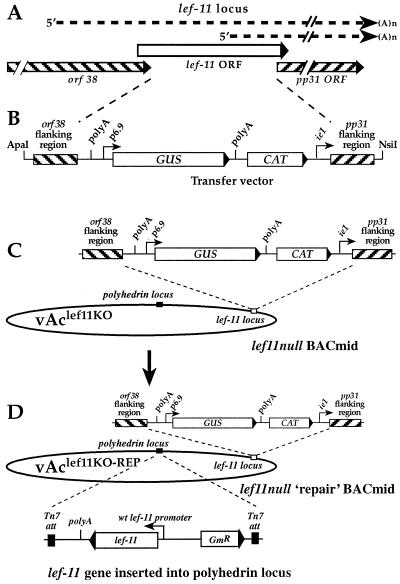FIG. 1.
Strategy for construction of a lef-11-null BACmid containing a deletion of the AcMNPV lef-11 gene and rescue by reinsertion of the wild-type (wt) lef-11 gene. (A) Relative locations and orientations of overlapping ORFs in the lef-11 locus of AcMNPV. The relative locations of lef-11 and pp31 transcripts are indicated by dashed lines. (B) Organization of the transfer vector DNA used to generate the lef-11 knockout BACmid by recombination in E. coli. A linear DNA fragment containing a poly(A) site, a p6.9 promoter-driven GUS gene, a chloramphenicol resistance gene cassette (CAT), and an ie1 promoter, are flanked by 1,034- and 1,026-bp regions from the orf38 and pp31 genes, as indicated. The linear DNA fragment was excised from plasmid pGEM72(f+)polyAie1Ppp31GUSorf38CAT, as described in Materials and Methods, and cotransfected with BACmid bMON14272 into E. coli strain BJ5183. (C) The organization of the lef-11-null BACmid (vAclef11KO) is shown. vAclef11KO was derived from BACmid bMON14272 and contains a chloramphenicol resistance gene cassette and a p6.9 promoter-driven GUS reporter gene in the lef-11 locus. The majority of the lef-11 ORF was removed. (D) Structure of the lef-11-null repair BACmid (vAclef11KO-REP). vAclef11KO-REP was derived from BACmid vAclef11KO by insertion of the wild-type lef-11 gene (under the control of the lef-11 promoter) into the polyhedrin locus by transposition with plasmid pFastBAClef11-REP.

